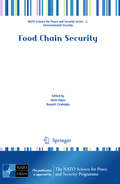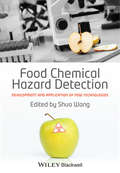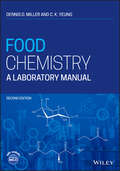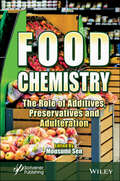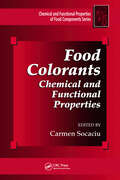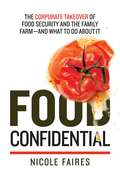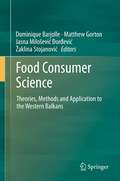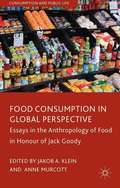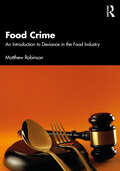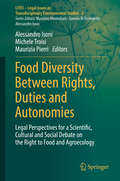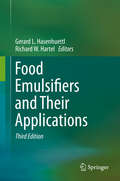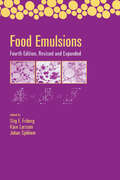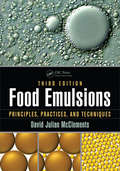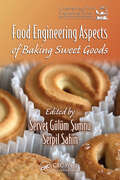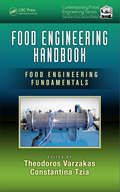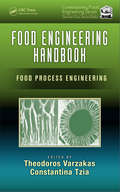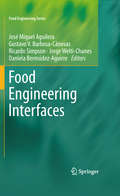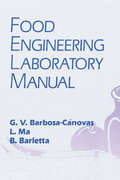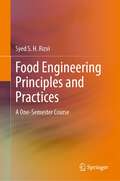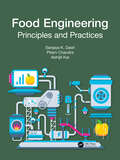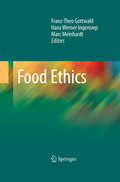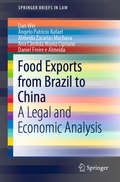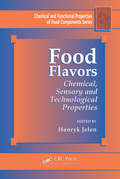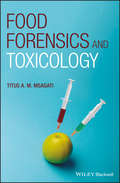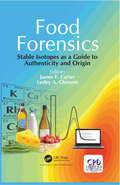- Table View
- List View
Food Chain Security
by Hami Alpas Beyazit ÇırakoğluThis volume addresses a wide range of issues related to food terrorism, food security and safety in a comprehensive and up-to-date survey. Emerging issues in Food Chain Security relevant to all countries and stakeholders are summarized, including relevant technical information relating to the various strands. These include: risk assessment and vulnerability; food defence strategies; awareness and response aspects. The analyses, based on practices and strategies evolved in different countries, yield an objective and scientific treatment of this vital area.
Food Chemical Hazard Detection: Development and Application of New Technologies
by Shuo WangFood chemical safety remains a serious concern to the food industry. Risks such as adulteration, the existence of toxic and allergenic compounds in foods, and poor regulation of postharvest processing indicate that food chemical safety is not fully guaranteed. With the increasing trend of globalization in the import and export of food products, the importance of employing accurate and reliable analytical instruments to rapidly detect chemical hazards in foods has become paramount. In recent years, many new applications for using a range of analytical methods to detect food chemical hazards have emerged. Food Chemical Hazard Detection: Development and Application of New Technologies aims to cover the major developments and applications in this field. With a far-reaching scope, this book includes sections dedicated to chromatography tandem mass spectrometry, immunoassay, biophotonics, nanotechnology, biosensors and microfluidic based “lab-on-a-chip”. A team of expert authors from major academic institutions in the USA, Canada and China bring a wealth of research experiences to bear in this major new work, which will be required reading for anyone interested in food chemical hazards and their effective detection and intervention strategies. Food Chemical Hazard Detection: Development and Application of New Technologies is aimed at a diverse audience, including food safety testing laboratories, scientists and managers in the global food supply chain, academic institutions, governmental regulatory agencies and food safety training providers. Readers will receive not only the fundamentals about different detection techniques, but will also gain insights into the current and future applications of each technique.
Food Chemistry: A Laboratory Manual
by Dennis D. Miller C. K. YeungFOOD CHEMISTRY A manual designed for Food Chemistry Laboratory courses that meet Institute of Food Technologists undergraduate education standards for degrees in Food Science In the newly revised second edition of Food Chemistry: A Laboratory Manual, two professors with a combined 50 years of experience teaching food chemistry and dairy chemistry laboratory courses deliver an in-depth exploration of the fundamental chemical principles that govern the relationships between the composition of foods and food ingredients and their functional, nutritional, and sensory properties. Readers will discover practical laboratory exercises, methods, and techniques that are commonly employed in food chemistry research and food product development. Every chapter offers introductory summaries of key methodological concepts and interpretations of the results obtained from food experiments. The book provides a supplementary online Instructor’s Guide useful for adopting professors that includes a Solutions Manual and Preparation Manual for laboratory sessions. The latest edition presents additional experiments, updated background material and references, expanded end-of-chapter problem sets, expanded use of chemical structures, and: A thorough emphasis on practical food chemistry problems encountered in food processing, storage, transportation, and preparation Comprehensive explorations of complex interactions between food components beyond simply measuring concentrations Additional experiments, references, and chemical structures Numerous laboratory exercises sufficient for a one-semester course Perfect for students of food science and technology, Food Chemistry: A Laboratory Manual will also earn a place in the libraries of food chemists, food product developers, analytical chemists, lab technicians, food safety and processing professionals, and food engineers.
Food Chemistry: The Role of Additives, Preservatives and Adulteration
by Mousumi SenFOOD CHEMISTRY A unique book detailing the impact of food adulteration, food toxicity and packaging on our nutritional balance, as well as presenting and analyzing technological advancements such as the uses of green solvents with sensors for non-destructive quality evaluation of food. Food Chemistry: The Role of Additives, Preservatives and Adulteration is designed to present basic information on the composition of foods and the chemical and physical changes that their characteristics undergo during processing, storage, and handling. Details concerning recent developments and insights into the future of food chemical risk analysis are presented, along with topics such as food chemistry, the role of additives, preservatives, and food adulteration, food safety objectives, risk assessment, quality assurance, and control. Moreover, good manufacturing practices, food processing systems, design and control, and rapid methods of analysis and detection are covered, as well as sensor technology, environmental control, and safety. The book also presents detailed information about the chemistry of each major class of food additive and their multiple functionalities. In addition, numerous recent findings are covered, along with an explanation of how their quality is ascertained and consumer safety ensured. Audience The core audience of this book include food technologists, food chemists, biochemists, biotechnologists, food, and beverage technologists, and nanoscientists working in the field of food chemistry, food technology, and food and nanoscience. In addition, R&D experts, researchers in academia and industry working in food science/safety, and process engineers in industries will find this book extremely valuable.
Food Colorants: Chemical and Functional Properties (Chemical & Functional Properties of Food Components)
by Carmen SocaciuDrawing on the expertise of internationally known, interdisciplinary scientists and researchers, Food Colorants: Chemical and Functional Properties provides an integrative image of the scientific characteristics, functionality, and applications of color molecules as pigments in food science and technology, as well as their impact on health. The boo
Food Confidential: The Corporate Takeover of Food Security and the Family Farm?and What to Do About It
by Nicole FairesFight the power and protect your family from the corporate interests that control our food chain. When author and homesteader Nicole Faires decided to retrofit an old school bus and tour America’s small farms with her husband and two small children, she expected to learn a lot, be inspired, and have some fun. But what she found disturbed her. Mismanaged small farms; clueless urbanites setting up shop to "get back to the land”; a mindless devotion to organic farming; and, ultimately, the discovery of just how dependent we are on corporations for our food. She began to understand how dangerous and fragile our food system really is. Climate change. Farmers retiring or going out of business. Corporations controlling our food distribution system while being protected from the consequences when they endanger our health. Skyrocketing food prices. Outsourced food production. With this admittedly bleak assessment of the current state of affairs, Nicole and her family decided to abandon the bus trip and instead start a farm. "I couldn’t tell people the solutions to our food crisis while I was traipsing around America taking photos. I had to live it,” Nicole says. And so the seeds for Food Confidential were sown. Our basic right to healthy food is at risk. What can we do? Written in an astute, engaging style, armed with examples from her own homesteading lifestyle, small farmer Nicole Faires’s Food Confidential gives you the tools to fight the intangible battles, as well as the practical ones.
Food Consumer Science
by Dominique Barjolle Jasna Milošević Đorđević Žaklina Stojanović Matthew GortonThis book explores the main methods, models, and approaches of food consumer science applied to six countries of the Western Balkans, illustrating each of these methods with concrete case studies. Research conducted between 2008 and 2011 in the course of the FOCUS-BALKANS project forms an excellent database for exploring recent changes and trends in food consumption.
Food Consumption in Global Perspective
by Jakob A. Klein Anne MurcottWith studies of China, India, West Africa, South America and Europe, this book provides a global perspective on food consumption in the modern world. Combing ethnographic, historical and comparative analyses, the volume celebrates the contributions of Jack Goody to the anthropology of food.
Food Crime: An Introduction to Deviance in the Food Industry
by Matthew RobinsonThis book addresses the various forms of deviance and criminality found within the conventional food system. This system—made up of numerous producers, processors, distributors, and retailers of food—has significant, far-reaching consequences bearing upon the environment and society.Food Crime broadly outlines the processes and impacts of this food system most relevant for the academic discipline of criminology, with a focus on the negative health outcomes of the US diet (e.g., obesity and diabetes) and negative outcomes associated with the system itself (e.g., environmental degradation). The author introduces the concept of "food criminology," a new branch of criminology dedicated to the study of deviance in the food industry. Demonstrating the deviance and criminality involved in many parts of the conventional food system, this book is the first to provide exhaustive coverage of the major issues related to what can be considered food crime. Embedded in the context of state-corporate criminality, the concepts and practices exposed in this book bring attention to harms associated with the conventional food system and illustrate the degree of culpability of food companies and government agencies for these harms.This book is of interest to students, scholars, and practitioners seeking a more just and healthy food system and encourages further future research into food crimes in the disciplines of criminology, criminal justice, and sociology.
Food Diversity Between Rights, Duties and Autonomies: Legal Perspectives For A Scientific, Cultural And Social Debate On The Right To Food And Agroecology (Lites - Legal Issues In Transdisciplinary Environmental Studies #2)
by Alessandro Isoni Michele Troisi Maurizia PierriThe book reflects on the issues concerning, on the one hand, the difficulty in feeding an ever- increasing world population and, on the other hand, the need to build new productive systems able to protect the planet from overexploitation. The concept of “food diversity” is a synthesis of diversities: biodiversity of ecological sources of food supply; socio-territorial diversity; and cultural diversity of food traditions. In keeping with this transdisciplinary perspective, the book collects a large number of contributions that examine, firstly the relationships between agrobiodiversity, rural sustainable systems and food diversity; and secondly, the issues concerning typicality (food specialties/food identities), rural development and territorial communities. Lastly, it explores legal questions concerning the regulations aiming to protect both the food diversity and the right to food, in the light of the political, economic and social implications related to the problem of feeding the world population, while at the same time respecting local communities’ rights, especially in the developing countries. The book collects the works of legal scholars, agroecologists, historians and sociologists from around the globe.
Food Emulsifiers and Their Applications
by Richard W. Hartel Gerard L. HasenhuettlEmulsifiers, also known as surfactants, are often added to processed foods to improve stability, texture, or shelf life. These additives are regulated by national agencies, such as the FDA, or multi-national authorities, such as the EEC or WHO. The amphiphilic molecules function by assisting the dispersion of mutually insoluble phases and stabilizing the resulting colloids, emulsions, and foams. Emulsifiers can interact with other food components such as carbohydrates, proteins, water, and ions to produce complexes and mesophases. These interactions may enhance or disrupt structures and affect functional properties of finished foods. In dairy processing, small molecule emulsifiers may displace dairy proteins from oil/water and air/water interfaces, which affects stability and properties of the foams and emulsions. In baked products, emulsifiers contribute to secondary functionalities, such as dough strengthening and anti-staling. Synthetic food emulsifiers suffer from the stigma of chemical names on a product’s ingredient statement. Modern consumers are seeking products that are “all natural.” Fortunately, there are a number of natural ingredients that are surface-active, such as lecithin, milk proteins, and some protein-containing hydrocolloids. Mayonnaise, for example, is stabilized by egg yolk. This book can serve as both a guide for professionals in the food industry to provide an understanding of emulsifier functionality, and a stimulus for further innovation. Students of food science will find this to be a valuable resource.
Food Emulsions (Food Science and Technology)
by Johan Sjöblom Stig E. Friberg Kåre LarssonUpholding the standards that made previous editions so popular, this reference focuses on current strategies to analyze the functionality and performance of food emulsions and explores recent developments in emulsion science that have advanced food research and development. Written by leading specialists in the field, the Fourth Edition probes the latest technologies in food emulsion assessment for excellence in food product design and focuses on methods of emulsion characterization and investigation. It contains new discussions on droplet analysis, surface forces, and the rheology of emulsions and examines essential components of everyday foods such as breads, condiments, margarine, and cheese.
Food Emulsions: Principles, Practices, and Techniques, Third Edition
by David Julian McClementsContinuing the mission of the first two editions, Food Emulsions: Principles, Practices, and Techniques, Third Edition covers the fundamentals of emulsion science and demonstrates how this knowledge can be applied to control the appearance, stability, and texture of emulsion-based foods. Initially developed to fill the need for a single resource co
Food Engineering Aspects of Baking Sweet Goods
by Serpil Sahin Servet Gülüm ŞumnuMost baking books do not focus on the simultaneous heat and mass transfer that occurs in the baking process, thereby ignoring a fundamental facet of process and product development. Addressing the engineering and science elements often ignored in current baking books, Food Engineering Aspects of Baking Sweet Goods explores important topics i
Food Engineering Handbook: Food Engineering Fundamentals (Contemporary Food Engineering)
by Theodoros Varzakas Constantina TziaFood Engineering Handbook: Food Engineering Fundamentals provides a stimulating and up-to-date review of food engineering phenomena. Combining theory with a practical, hands-on approach, this book covers the key aspects of food engineering, from mass and heat transfer to steam and boilers, heat exchangers, diffusion, and absorption. A complement to
Food Engineering Handbook: Food Process Engineering (Contemporary Food Engineering)
by Theodoros Varzakas Constantina TziaFood Engineering Handbook: Food Process Engineering addresses the basic and applied principles of food engineering methods used in food processing operations around the world. Combining theory with a practical, hands-on approach, this book examines the thermophysical properties and modeling of selected processes such as chilling, freezing, and dehy
Food Engineering Interfaces
by Gustavo Barbosa-Canovas Daniela Bermudez Aguirre Jorge Welti-Chanes José Miguel Aguilera Ricardo SimpsonThe International Conference on Food Engineering is held every four years and draws global participation. ICEF 10 will be held in April 2008 in Chile with the theme of food engineering at interfaces. This will not be a typical proceedings with uneven contributions. Papers will be solicited from each plenary speaker plus two or three invited speakers from each topic and the goal is to publish a book that conveys the interdisciplinary spirit of the meeting as well as covers the topics in depth, creating a strong reference work. The idea is to explore how food engineers have to be prepared in years ahead not only to perform in their normal activities but also to engage in new challenges and opportunities that will make the profession more attractive, responsive, and able to create a larger impact. These challenges and opportunities are within the profession and at interfaces with other areas. A major role of engineers is to incorporate new knowledge into the profession and respond to practical needs. The goal is to explore how food engineers are integrating developments in the basic sciences of physics and chemistry, nutrition, informatics, material sciences, genomics (and other -omics), quality and safety, consumer behavior and gastronomy. Interfaces with the environment, the business sector, regulations and export markets are also important to consider.
Food Engineering Laboratory Manual
by Li Ma Gustavo V. Barbosa-Canovas Blas J. BarlettaFROM THE PREFACE The purpose of this laboratory manual is to facilitate the understanding of the most relevant unit operations in food engineering. The first chapter presents information on how to approach laboratory experiments; topics covered include safety, preparing for a laboratory exercise, effectively performing an experiment, properly documenting data, and preparation of laboratory reports. The following eleven chapters cover unit operations centered on food applications: dehydration . . . . , thermal processing, friction losses in pipes, freezing, extrusion, evaporation, and physical separations. These chapters are systematically organized to include the most relevant theoretical background pertaining to each unit operation, the objectives of the laboratory exercise, materials and methods . . ., expected results, examples, questions, and references. The experiments presented have been designed for use with generic equipment to facilitate the adoption of this manual . . . .
Food Engineering Principles and Practices: A One-Semester Course
by Syed S. RizviThis textbook is designed for a one-semester course on Food Engineering, and it offers a concise, in-depth and integrated introduction to the fundamental engineering and physicochemical principles and practices of utility in food processing and manufacturing operations. The textbook includes topics mandated by the Institute of Food Technologists for accreditation of Food Science curricula and helps prepare the students better for taking advance courses related to unit operations in food manufacturing. It is also relevant for Food Process Engineering courses, containing materials that most instructors can cover in three semester hours of instruction. In the first three chapters, readers will find an overview of the basic knowledge of physics and chemistry and an introduction to the engineering language needed to eliminate confusion going forward. In the following chapters, the author covers the main concepts of food thermodynamics, heat transfer–radiation in foodmaterials, mass transfer and fluid dynamics in food, along with real-life examples and exercises to help students relate better to the topics. The author also gives a brief introduction to the main mathematical and analytical concepts required in food engineering.This textbook equips readers to understand a diversity of food engineering related topics and each chapter is enriched with practical examples and Check Your Understanding sections, as well as several problems. The textbook is aimed at undergraduate food science students in their first required introductory food engineering course, but practitioners involved in designing, optimizing, and managing the processing of food products will also find it a useful account.
Food Engineering: Principles and Practices
by Sanjaya K. Dash Pitam Chandra Abhijit KarStudents entering the food processing stream need to acquire knowledge of concepts and analytical skills together with the knowledge of their applications. Food Engineering: Principles and Practices explains the different unit operations in food processing with an emphasis on the principles of food engineering as well as the different types of equipment used for the purpose. An approach in which propounding concepts and theory is immediately followed by numerical examples makes this book unique among food engineering textbooks. The examples, which are thoroughly explicated, have been taken, in general, from different competitive examinations and have been selected with practical applications for a better appreciation and understanding by the students. In the case of equipment, the constructional and operational features are discussed along with the specialty features of these types of equipment for better understanding their applications. Key Features: Merges a presentation of food engineering fundamentals with a discussion of unit operations and food processing equipment; Reviews concepts comprehensively with suitable illustrations and problems; Provides an adequate number of examples with different levels of difficulty to give ample practice to students; Explains equipment units in three broad subheadings: construction and operation, salient features, and applications This book is written as a textbook for students of food processing and food technology. Therefore, the book is meant for undergraduate and graduate students pursuing food processing and food technology courses. It also serves as a reference book for shop floor professionals and food processing consultants.
Food Ethics
by Franz-Theo Gottwald Marc Meinhardt Hans Werner IngensiepIn this first decade of the 21st century, more than 854 million people in the world are starving, while industrial nations are debating about obesity, generating energy from food plants, and a myriad of other topics many African and south Asian nations could only fathom. In this great discord, there have arisen many interdisciplinary discussions about problems in the field of applied Ethics, with regards to food, that are crossing a considerably wide spectrum of disciplines, such as: obesity, traceability, agro-food biotechnology, dairy industry, transgenic plants, novel food, bio fuels, world-trade system, etc. This book presents international discussions and information concerning food ethics in its current state. It presents a variety of important aspects in the field of food ethics with respect to positions, instruments and applications of issues surrounding nutrition. A great deal of the book will concern itself with discussing different ethical positions and problems of current interests, as explained by experts of the "food-ethics-community". The articles will focus on the reality of global food problems through two main issues: current questions of nutrition in the specific contexts of field and experience, ethical tools, ideas and suggestions concerning long-term steps for solutions. The appendix presents a collection of current declarations and political statements - visions, proposals and goals in a worth living world in general and concerning specific problems - water, healthy food, the human right to food, sustainability and food sovereignty.
Food Exports from Brazil to China: A Legal and Economic Analysis (SpringerBriefs in Law)
by Dan Wei Ângelo Patrício Rafael Almeida Zacarias Machava Ana Cândida Muniz Cipriano Daniel Freire e AlmeidaThis book provides an essential overview of trade between Brazil and China, analyzes the regulatory framework for Brazil’s foodstuff exportation and China’s foodstuff importation, and identifies the main products, market shares, barriers to market access, and e-commerce strategies. The book also addresses the importance of consumer health and the latest developments regarding the United Nations Guidelines for Consumer Protection. Lastly, based on the statistics for Brazil’s food exports to Mainland China, Hong Kong and Macau as separate customs areas, the book explores the role of Macau and calls for intensifying its links with Portuguese-speaking countries, including Brazil.
Food Flavors: Chemical, Sensory and Technological Properties (ISSN)
by Henryk JeleńFood flavor, appearance, and texture are the sensory properties that influence food acceptance, and among these, flavor is usually the decisive factor for the choice of a particular product. Food Flavors: Chemical, Sensory, and Technological Properties explores the main aspects of food flavors and provides a starting point for further study in focu
Food Forensics and Toxicology
by Titus A. MsagatiA comprehensive guide, offering a toxicological approach to food forensics, that reviews the legal, economic, and biological issues of food fraud Food Forensics and Toxicology offers an introduction and examination of forensics as applied to food and foodstuffs. The author puts the focus on food adulteration and food fraud investigation. The text combines the legal/economic issues of food fraud with the biological and health impacts of consuming adulterated food. Comprehensive in scope, the book covers a wide-range of topics including food adulteration/fraud, food "fingerprinting" and traceability, food toxicants in the body, and the accidental or deliberate introduction of toxicants into food products. In addition, the author includes information on the myriad types of toxicants from a range of food sources and explores the measures used to identify and quantify their toxicity. This book is designed to be a valuable reference source for laboratories, food companies, regulatory bodies, and researchers who are dealing with food adulteration, food fraud, foodborne illness, micro-organisms, and related topics. Food Forensics and Toxicology is the must-have guide that: Takes a comprehensive toxicological approach to food forensics Combines the legal/economic issue of food fraud with the biological/health impacts of consuming adulterated food in one volume Discusses a wide range of toxicants (from foods based on plants, animals, aquatic and other sources) Provides an analytical approach that details a number of approaches and the optimum means of measuring toxicity in foodstuffs Food Forensics and Toxicology gives professionals in the field a comprehensive resource that joins information on the legal/economic issues of food fraud with the biological and health implications of adulterated food.
Food Forensics: Stable Isotopes as a Guide to Authenticity and Origin
by James F. Carter Lesley A. ChessonFood forensics is a multi-disciplinary science involving advanced analytical techniques, plant and animal metabolism, and sophisticated data interpretation tools. This book explains how plants, and in turn animals eating those plants, assimilate stable isotopes and trace elements from their environments. It provides extensive reviews of the use of stable isotope and trace element measurements for the authentication of major food groups and how these can be used to detect fraudsters. The book emphasises the use of correct methods for sample preparation and measurement so that data can be compared to existing datasets, with a dedicated chapter discussing interpretations.
